Table of Contents
- Editor’s Choice
- LiDAR Market Revenue – by Application Statistics
- LiDAR for Automotive and Industrial Applications Statistics
- LiDAR System Sensor Sales Statistics
- Automotive LiDAR Shipments Statistics
- LiDAR for Robotic Car Market Statistics
- Patents Filed by Companies in the LiDAR Industry
- LiDAR Technology Regional Statistics
- LiDAR Price and Growth Rate Trends
- Challenges in Using LiDAR Technology Statistics
- Recent Developments
- Conclusion
- FAQs
LiDAR Statistics: LiDAR, an abbreviation for Light Detection and Ranging, is a remote sensing tool. Its functioning involves emitting laser pulses and subsequently gauging the time taken for their return.
Resulting in the development of intricate 3D representations of the nearby surroundings. This technology boasts a broad spectrum of applications, encompassing the generation of intricate topographical charts.
The management of forested areas, urban planning, and the investigation of historical sites. The navigation of self-driving vehicles, environmental surveillance, support for mining operations, and the examination of critical infrastructure.
LiDAR’s exactitude in distance measurement and its capacity to record characteristics such as object dimensions, form, and reflectivity. They are of immense value, making substantial contributions to progress in diverse sectors.
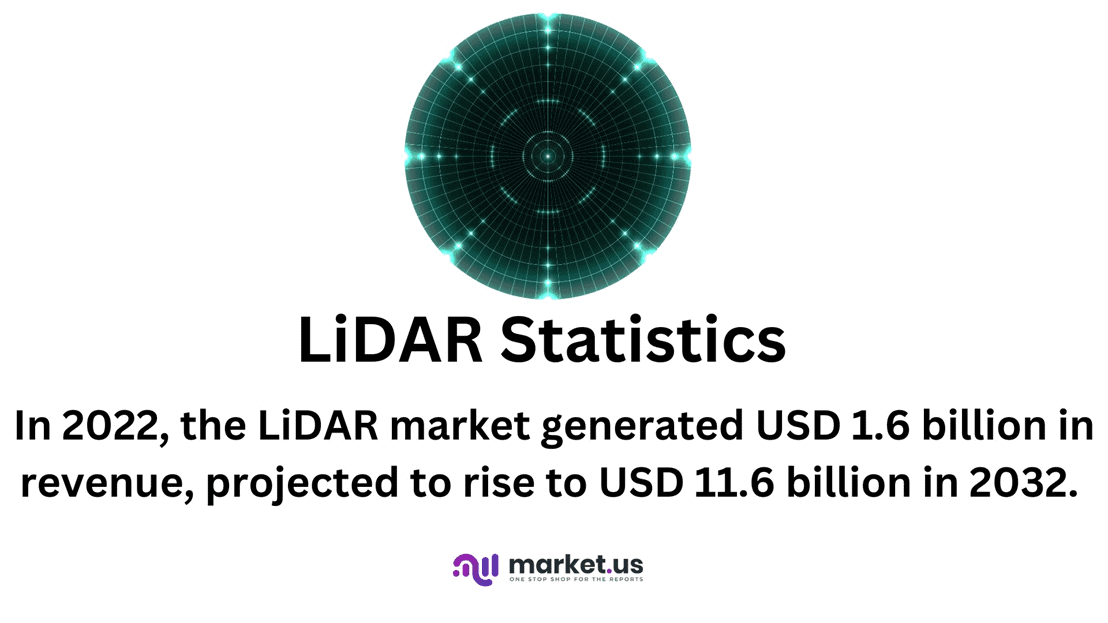
Editor’s Choice
- The LiDAR market is experiencing remarkable growth at a CAGR of 22.5%.
- In 2022, the LiDAR market generated USD 1.6 billion in revenue. Which is projected to rise to USD 11.6 billion in 2032.
- In 2022, the total revenue for the LiDAR market was USD 1.6 billion. With airborne LiDAR contributing USD 1 billion. Terrestrial LiDAR accounts for another USD 1 billion, and mobile & UAV LiDAR bring in no revenue.
- Notably, corridor mapping accounts for the largest market share at 34%. Reflecting the technology’s crucial role in creating detailed 3D maps for transportation and infrastructure planning.
- The LiDAR market catering to automotive and industrial applications is on the brink of substantial expansion. Its projected growth trajectory will take it from $2.1 billion in 2021 to a robust $6.3 billion by 2027.
- In 2022, the market size for solid-state and flash LiDAR systems amounted to USD 7 million. While mechanical LiDAR systems dominated with a market size of USD 2,225 million, underscoring their established presence.
- Between 2010 and 2019, General Motors led the pack with 103 LiDAR patents published during this period. Underlining their commitment to autonomous vehicle development.
Global LiDAR Market Size Statistics
- The LiDAR market is experiencing remarkable growth at a CAGR of 22.5%, with revenues steadily increasing yearly.
- In 2022, the market generated USD 1.6 billion in revenue, projected to rise to USD 2.0 billion in 2023.
- The trend continues with anticipated revenues of USD 2.3 billion in 2024 and USD 3.0 billion in 2025.
- By 2026, the market is expected to reach USD 3.8 billion, and this growth trajectory remains robust in subsequent years.
- In 2027, LiDAR market revenue is predicted to soar to USD 4.5 billion, followed by USD 5.1 billion in 2028.
- The market is poised for even more significant expansion in the years ahead. With projected revenues of USD 6.3 billion in 2029, and USD 7.5 billion in 2030. A substantial leap to USD 9.2 billion in 2031.
- The most striking growth is anticipated in 2032 when the LiDAR market is expected to reach a staggering USD 11.6 billion. Underscoring the increasing importance of LiDAR technology in various industries.
(Source: Market.us)
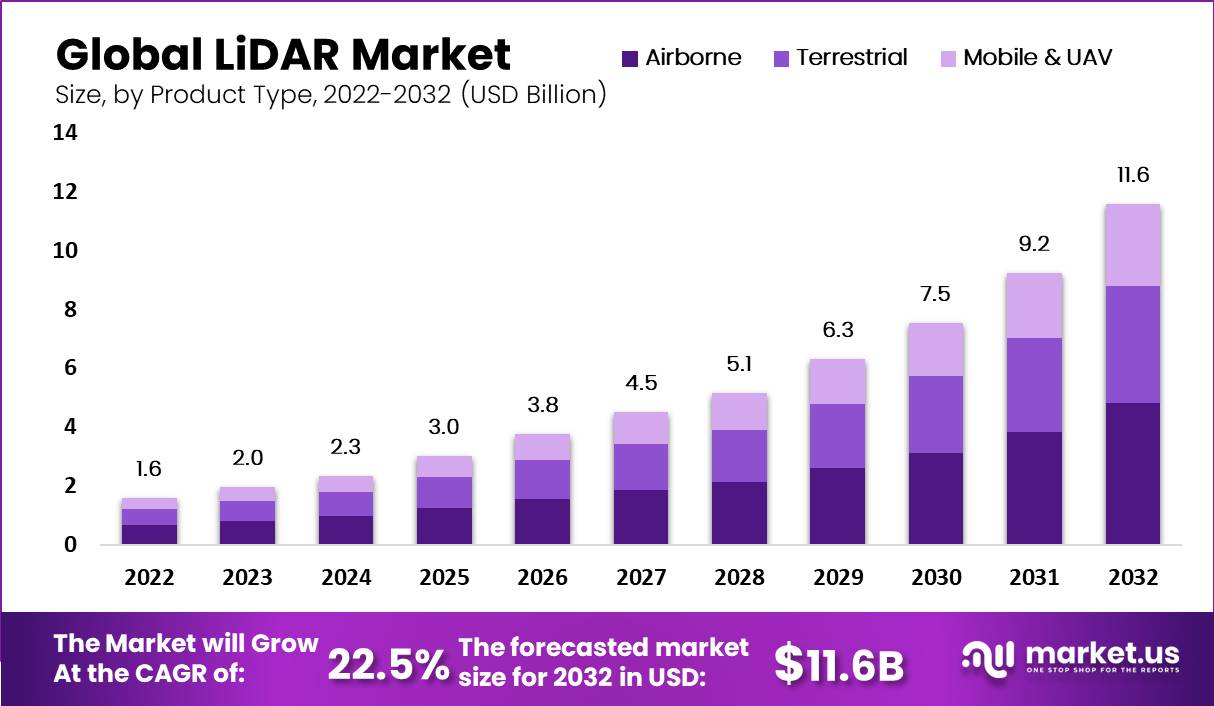
LiDAR Market Revenue – by Product Type Statistics
- In 2022, the total revenue for the LiDAR market was USD 1.6 billion, with airborne LiDAR contributing USD 1 billion, terrestrial LiDAR accounting for another USD 1 billion, and mobile & UAV LiDAR bringing in no revenue.
- The following year, in 2023, the total revenue saw a notable rise to USD 2 billion, with the same revenue distribution among the product types.
- The market is projected to continue its upward trend, with total revenues expected to reach USD 2.3 billion in 2024 and USD 3 billion in 2025.
- This growth is underpinned by an increasing demand for LiDAR technology in various applications, including mapping, surveying, and autonomous vehicles.
- In 2026, the total revenue is anticipated to reach USD 3.8 billion, driven by a surge in airborne LiDAR revenue to USD 2 billion.
- The terrestrial and mobile & UAV segments are expected to maintain their respective contributions at USD 1 billion each.
- As we move into 2027 and beyond, the LiDAR market is expected to expand, with total revenues reaching USD 4.5 billion in 2027 and steadily climbing to USD 11.6 billion in 2032.
- Airborne and terrestrial LiDAR revenues will grow significantly during this period, reaching USD 5 billion and USD 4 billion by 2032.
- The mobile & UAV LiDAR segment is also poised for substantial growth, reaching USD 3 billion in revenue by 2032.
- In conclusion, the global LiDAR market is experiencing robust growth, driven by the increasing adoption of LiDAR technology across various industries. This growth trend is expected to continue over the next decade, with all product types contributing significantly to the market’s expansion.
(Source: Market.us)

LiDAR Market Revenue – by Application Statistics
- The LiDAR market exhibits diverse revenue distribution across various applications, with each sector contributing uniquely to its growth.
- Notably, corridor mapping accounts for the largest market share at 34%. Reflecting the technology’s crucial role in creating detailed 3D maps for transportation and infrastructure planning.
- Advanced Driver Assistance Systems (ADAS) closely follows at 26%. Underlining LiDAR’s integral position in the automotive industry for enhancing vehicle safety and autonomy.
- Exploration and detection applications claim a 17% market share, illustrating LiDAR’s value in geological surveys, archaeological research, and forestry.
- Engineering applications contribute 12% of the market, emphasizing its use in construction and civil engineering projects.
- At 7%, environmental applications showcase LiDAR’s role in monitoring and conserving natural ecosystems.
- Finally, other applications collectively represent 4% of the market, indicating its versatility in addressing diverse needs beyond the dominant sectors.
- This distribution highlights the multifaceted impact of LiDAR technology across various domains, contributing to its continued expansion and market significance.
(Source: Market.us)
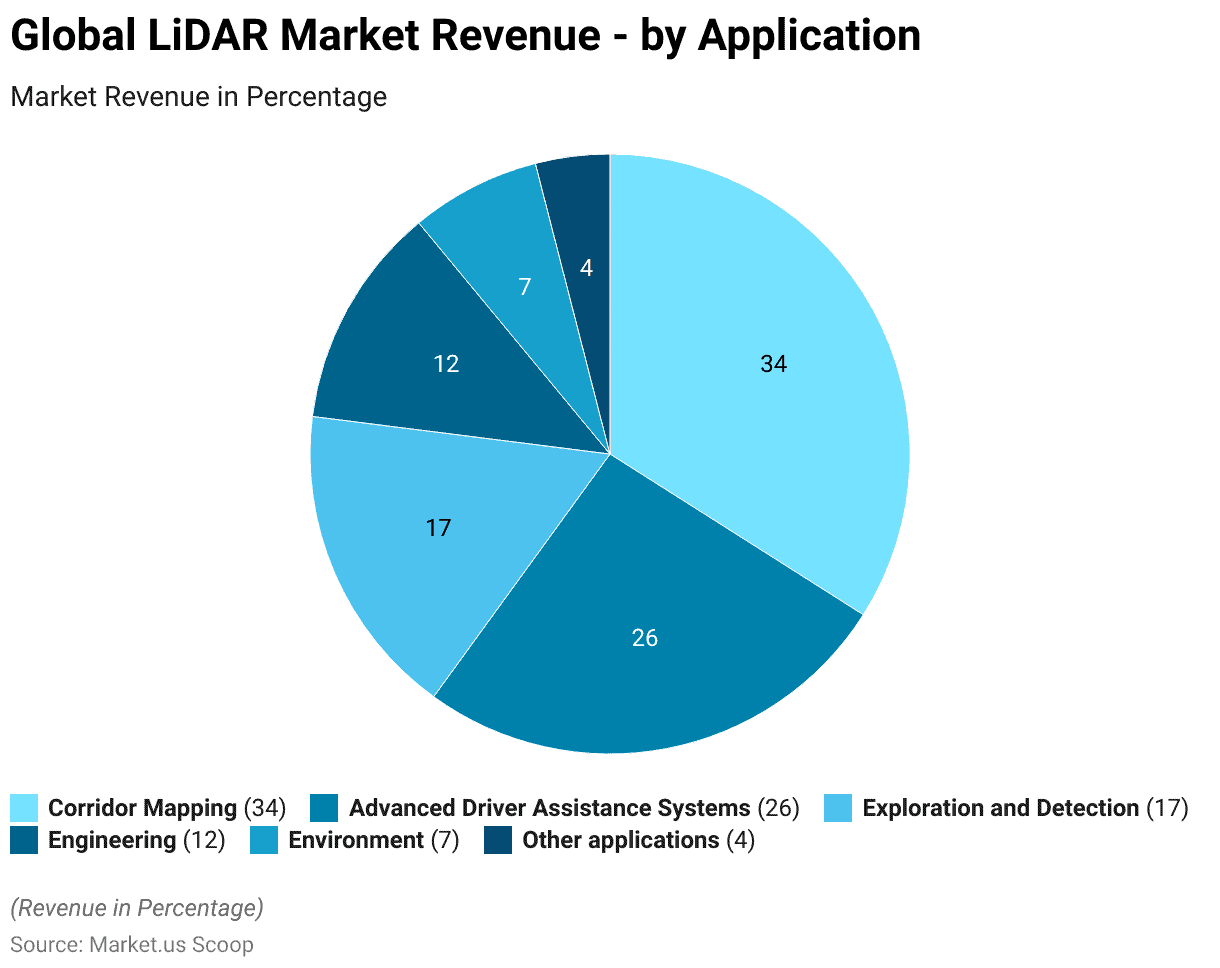
LiDAR for Automotive and Industrial Applications Statistics
- The LiDAR market catering to automotive and industrial applications is on the brink of substantial expansion. Its projected growth trajectory will take it from $2.1 billion in 2021 to a robust $6.3 billion by 2027.
- This growth is underpinned by a strong compound annual growth rate (CAGR) of 22% from 2022 to 2027.
- The automotive sector will be the primary driver of this expansion. The automotive LiDAR market is expected to witness remarkable growth. Escalating from a modest $38 million in 2021 to an impressive $2.0 billion in 2027.
- Notably, the automotive LiDAR market has gained significant momentum by announcing 55 design wins since 2018.
- Furthermore, the LiDAR market will see a substantial boost from robotic car applications. With a projected market value of $698 million in 2027, marking a significant leap from $120 million in 2021.
- However, the burgeoning LiDAR market’s reach extends beyond the automotive realm. Remarkably, various ongoing projects are integrating LiDAR technology into smart infrastructure initiatives, encompassing activities such as intersection monitoring and security.
- This is anticipated to drive the LiDAR market for smart infrastructure to a substantial $1.1 billion by 2027. A substantial increase from its $108 million valuation in 2021.
- Additionally, the automation of logistics operations is contributing to LiDAR’s growth. With the logistics LiDAR market projected to reach $344 million in 2027. Reflecting a notable escalation from its $92 million worth in 2021.
- These trends collectively underscore the extensive array of applications and the rising importance of LiDAR technology across many sectors.
(Source: Yole Group)
LiDAR System Sensor Sales Statistics
- The global LiDAR system sensor sales have significantly increased over the past decade. Underscoring the technology’s expanding role in various industries.
- In 2014, the total sales amounted to USD 268.5 million, reflecting a modest but growing interest in LiDAR applications.
- However, by 2022, the LiDAR market had experienced remarkable growth, with total sensor sales reaching a substantial USD 944.3 million.
- This substantial increase, nearly quadrupling the 2014 figures, underscores the increasing demand for LiDAR technology.
- This growth can be attributed to its extensive applications. Including autonomous vehicles, environmental monitoring, and urban planning. As well as advancements in LiDAR sensor technology that have made it more cost-effective and accessible to a wider range of industries.
(Source: Statista)
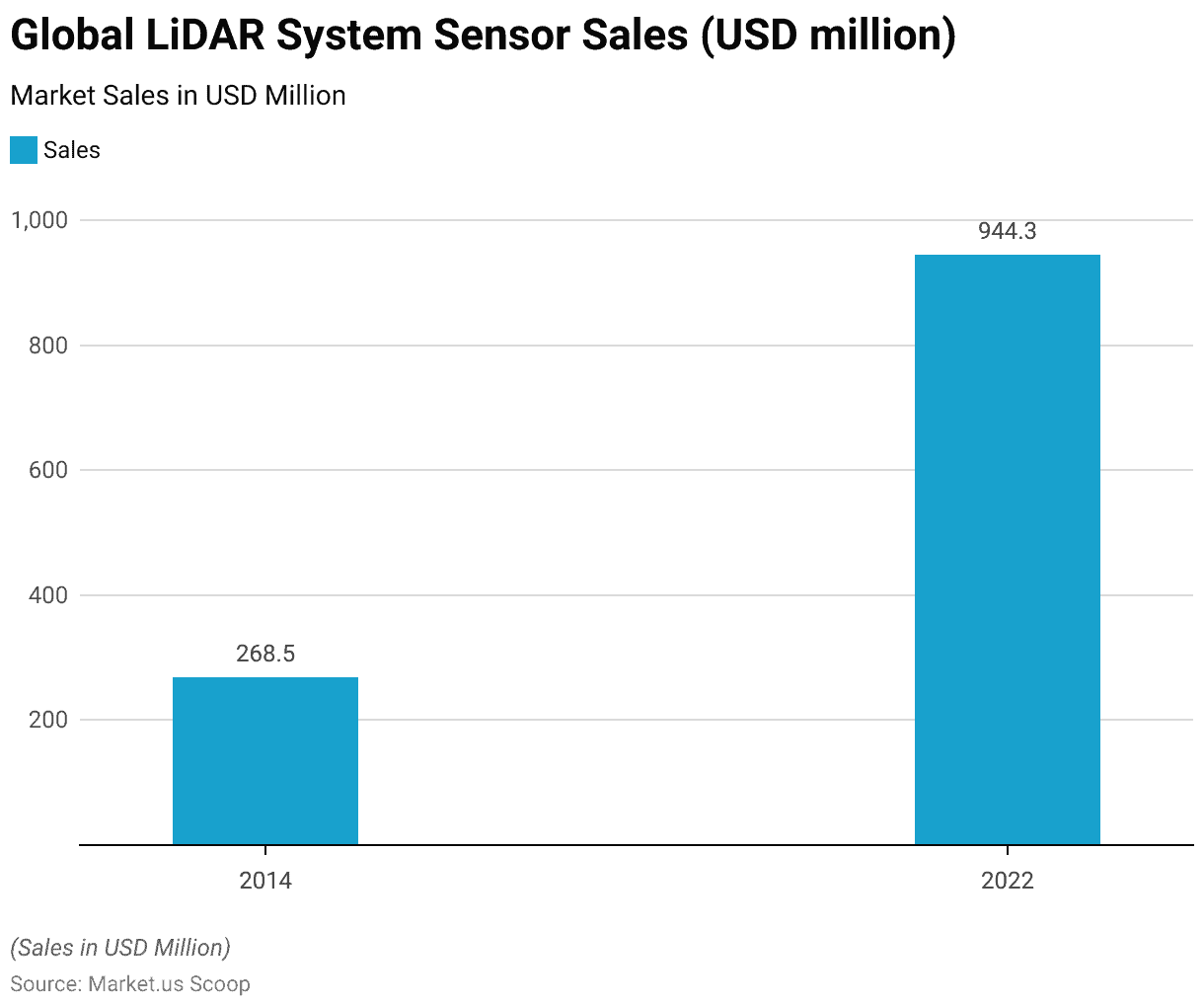
Automotive LiDAR Shipments Statistics
- The global automotive LiDAR market is poised for substantial growth between 2022 and 2032. Driven by the increasing adoption of LiDAR technology in the automotive industry.
- In 2022, automotive LiDAR shipments stood at 1.4 million units, signaling the technology’s early presence in the sector.
- However, as autonomous vehicles and advanced driver assistance systems (ADAS) gain momentum. The demand for LiDAR sensors is projected to surge.
- By 2027, shipments are estimated to reach 10.9 million units, representing a significant increase in just five years.
- Looking further ahead to 2032, the market is forecasted to experience exponential growth. With automotive LiDAR shipments expected to reach a staggering 34 million units.
- This substantial expansion underscores the integral role LiDAR plays in enhancing vehicle safety and enabling autonomous driving. Making it a pivotal component in the future of automotive technology.
(Source: Statista)

LiDAR for Robotic Car Market Statistics
- The global LiDAR market for robotic cars is set to undergo significant transformation and expansion from 2022 to 2032, reflecting the evolution of LiDAR technology and its integration into autonomous vehicles.
- In 2022, the market size for solid-state and flash LiDAR systems amounted to USD 7 million, while mechanical LiDAR systems dominated with a market size of USD 2,225 million, underscoring their established presence.
- However, as solid-state and flash LiDAR technology advances and gains prominence, the market landscape is projected to shift dramatically.
- By 2032, the market size for solid-state and flash LiDAR is anticipated to soar to USD 1,492 million, indicating a remarkable increase driven by their compactness and efficiency.
- Concurrently, the market size for all mechanical LiDAR systems is expected to reach USD 6,719 million, reflecting sustained demand.
- This evolving market underscores the pivotal role LiDAR plays in shaping the future of robotic cars, contributing to enhanced safety and autonomy in the automotive industry.
(Source: Statista)
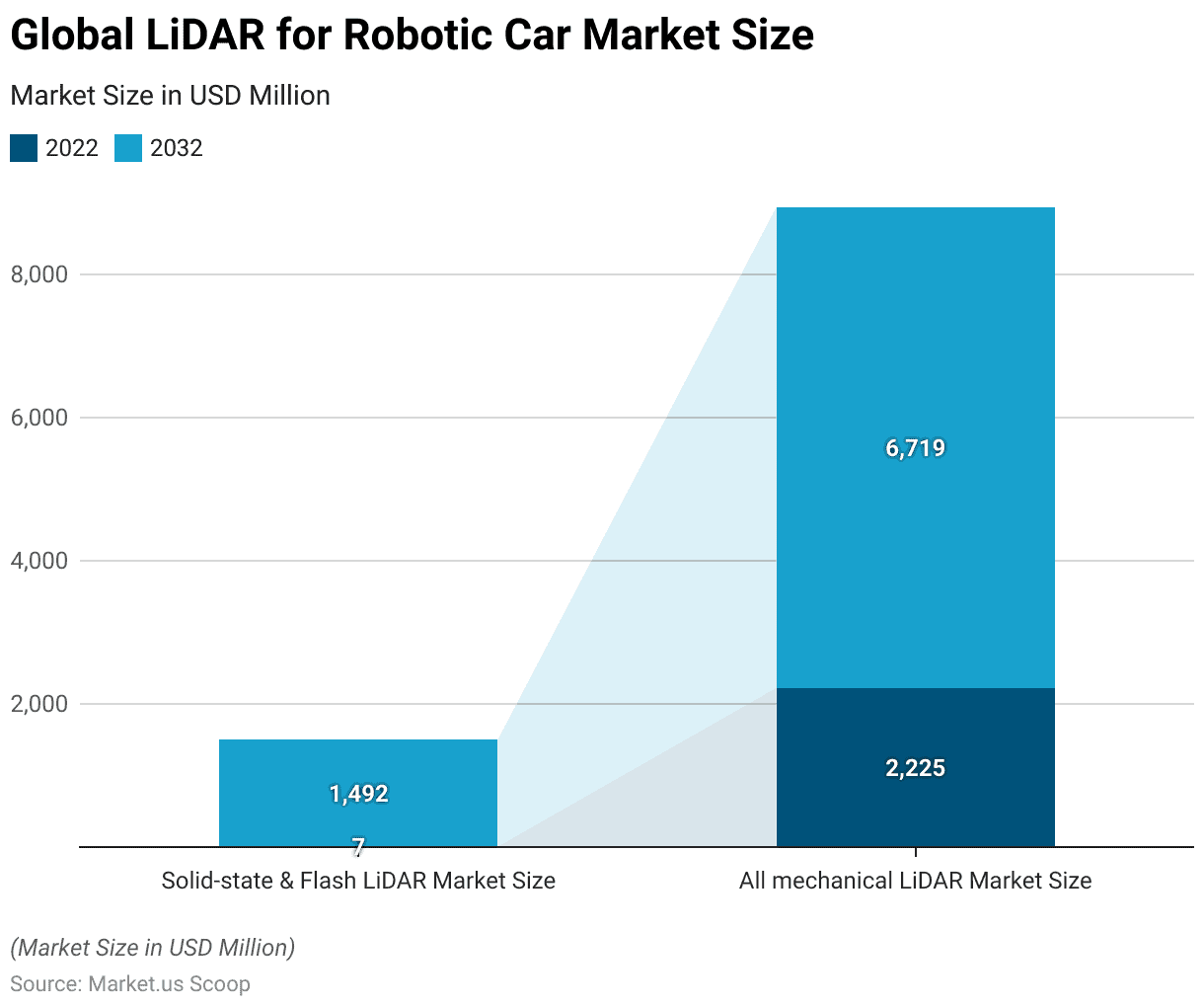
Patents Filed by Companies in the LiDAR Industry
- Between 2010 and 2019, the United States saw a surge in LiDAR patents published by various companies and entities, reflecting the growing importance of this technology in numerous industries.
- Several notable companies and organizations contributed significantly to this patent landscape.
- General Motors led the pack with 103 LiDAR patents published during this period, underlining their commitment to autonomous vehicle development.
- Ford followed closely with 130 patents, emphasizing their investment in LiDAR technology.
- Waymo and Bosch were also prolific contributors, each publishing 64 patents, showcasing their dedication to advancing LiDAR for self-driving cars and related applications.
- Other key players included Aptiv/Delphi (50 patents), Uber (40 patents), and Toyota (44 patents), all actively innovating in the LiDAR domain.
- This vibrant patent activity underscores the fierce competition and rapid technological advancements in the LiDAR sector during 2010-2019, with various entities vying for leadership in this transformative field.
(Source: Cipher)

LiDAR Technology Regional Statistics
- Between 2018 and 2022, LiDAR supply agreements for Advanced Driver Assistance Systems (ADAS) vehicles have seen varying distribution levels across different countries.
- China has dominated this landscape, accounting for a substantial 50% of these agreements, reflecting the nation’s significant investment in ADAS technology and its rapid growth in the automotive sector.
- Meanwhile, France and the USA secured 18% of these supply agreements, underlining their strong presence in the ADAS market.
- Germany, Japan, and Israel claimed smaller but noteworthy shares at 6%, 4%, and 4%, respectively.
- These statistics illustrate the global collaboration and competition among nations in developing and deploying LiDAR technology to enhance the safety and capabilities of ADAS-equipped vehicles.
(Source: Yole Group)
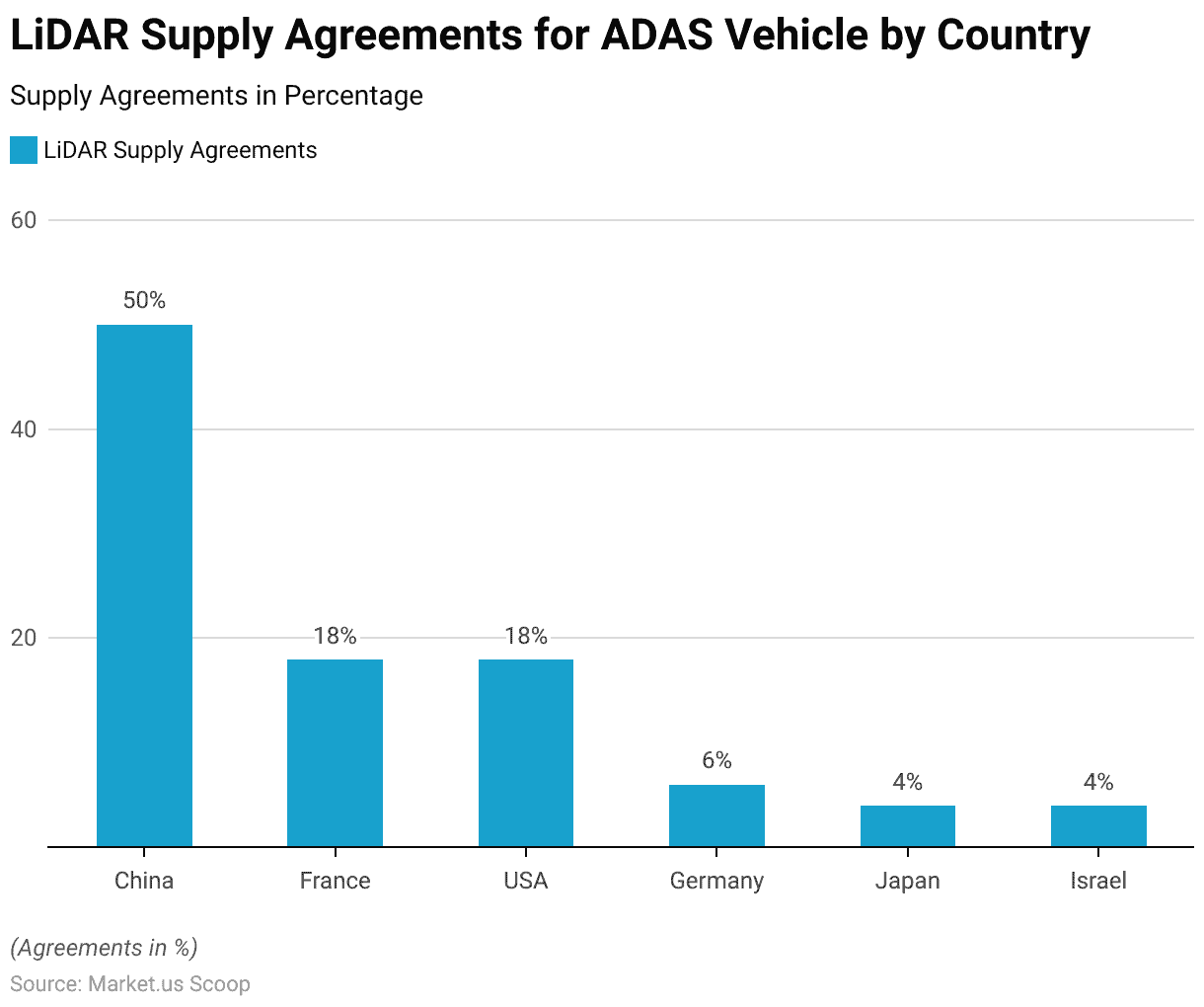
LiDAR Price and Growth Rate Trends
- The pricing and growth rate trends in the LiDAR industry over the past decade reveal a remarkable evolution.
- In 2007, LiDAR technology was relatively nascent and came with a hefty price tag of $80,000.
- However, as technological advancements and increased adoption unfolded, the cost of LiDAR systems witnessed a substantial decline.
- By 2014, the price had dropped to $8,000, marking a significant 90% reduction.
- This trend continued, with prices plummeting to $375 in 2017, reflecting a 95% decrease from 2014.
- The following years saw a consistent downward trajectory, with prices reaching $100 in 2020. Representing a 33% reduction from the previous year.
- These price reductions have played a pivotal role in expanding the accessibility of LiDAR technology across various industries, driving its adoption and growth.
(Source: Image Sensors World)
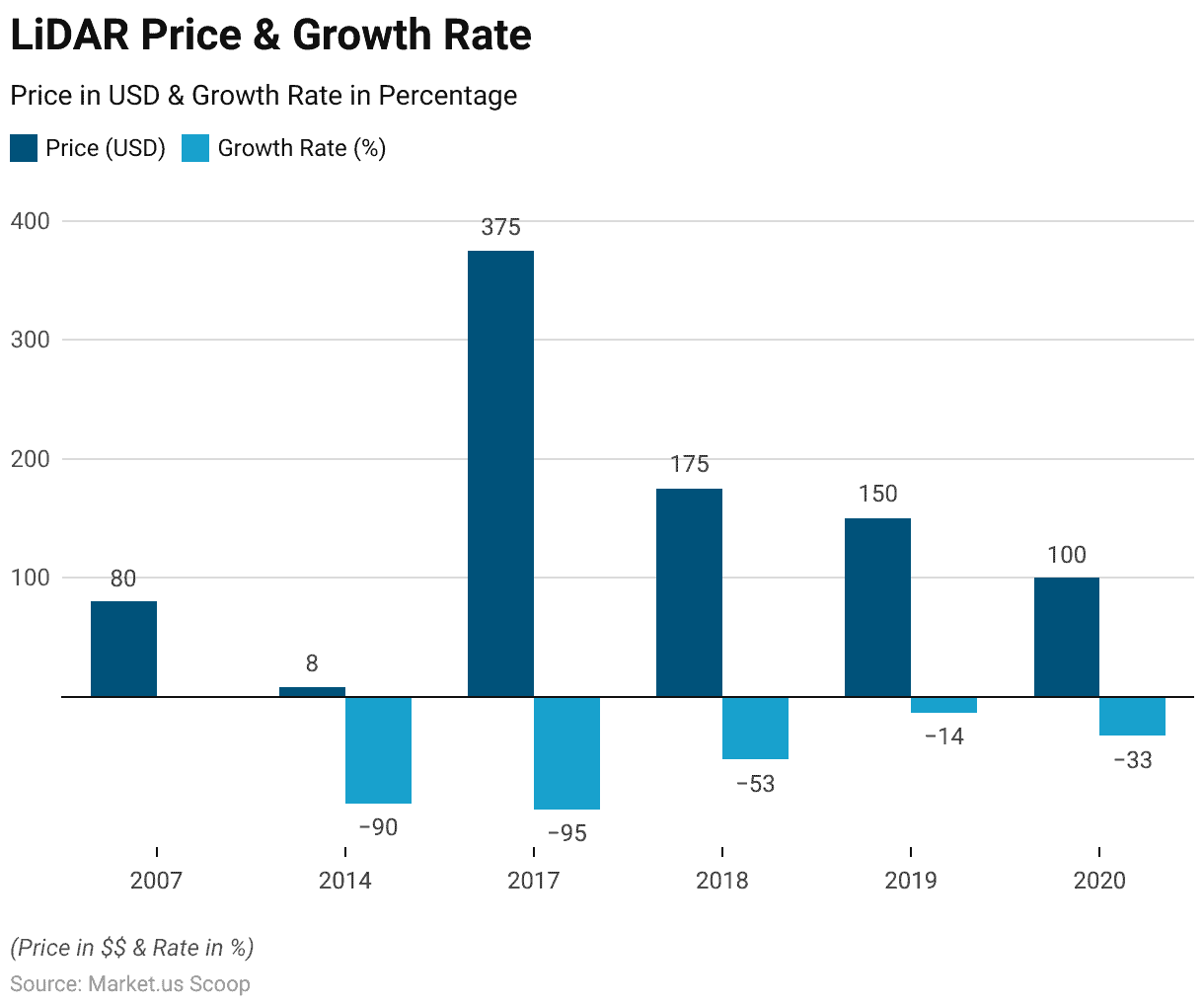
Challenges in Using LiDAR Technology Statistics
Cost of LiDAR Technology
- It’s imperative to take a comprehensive view of all the associated expenses to accurately assess the total costs and potential benefits of integrating LiDAR technology into your business operations.
- Firstly, the selection of the right tools is of paramount importance. An entry-level LiDAR system with robust capabilities typically comes with a price tag of $23,000 (in USD).
- If you opt to complement this with a drone, you should anticipate an additional investment ranging from $10,000 to $16,000.
- There are additional expenses to account for, such as acquiring accessories for your drone, procuring batteries, a base station, and a GPS rover, all of which are collectively contributing.
- Insurance is an often overlooked but crucial consideration, which is vital to safeguard your investment. For a LiDAR system valued at $23,000, it is advisable to allocate a minimum of $2,000 annually for equipment insurance.
(Source: LiDAR News)
Resource Challenges
- Another substantial facet to consider is the human resources required for successful implementation. You will need an individual holding a drone piloting license to gather the requisite data. In Canada, obtaining an “advanced drone license,”. Which includes study materials and examination fees, typically incurs an expenditure of approximately $550.
- In the United States, the FAA commercial drone pilot test, which is mandatory for those operating within the U.S. Involves a fee of $200, with an associated preparation period spanning approximately one week, totaling 15-30 hours.
- While the advantage of requiring only one person for data collection is notable. It is crucial to deliberate on who will be responsible for processing the LiDAR data. If you have a team member proficient in AutoCAD. They can undertake this task with a minimal time investment of 4-6 hours for software training.
- Lastly, it is worth noting that LiDAR processing software can come with a substantial price tag, often exceeding $20,000.
(Source: LiDAR News)
Recent Developments
Acquisitions and Mergers:
- Aeva Technologies acquires Ouster: In early 2024, Aeva Technologies, a leading developer of LiDAR technology, acquired Ouster for $400 million. This merger aims to combine their strengths in FMCW (Frequency Modulated Continuous Wave) LiDAR to enhance the performance and cost-effectiveness of LiDAR systems.
- Velodyne LiDAR merges with Graf Industrial: Velodyne LiDAR completed its merger with Graf Industrial Corp., a special purpose acquisition company (SPAC), in late 2023. This merger, valued at $1.8 billion, is intended to accelerate Velodyne’s growth and expand its market reach.
New Product Launches:
- Luminar’s Iris Plus: In mid-2023, Luminar introduced Iris Plus, an upgraded version of its high-performance automotive LiDAR. Iris Plus offers improved range, resolution, and reliability, targeting the autonomous vehicle market.
- InnovizTwo LiDAR: Innoviz Technologies launched the InnovizTwo LiDAR sensor in early 2024. This new sensor boasts enhanced detection capabilities, longer range, and higher accuracy, aiming to support advanced driver-assistance systems (ADAS) and autonomous driving.
Funding:
- Quanergy Systems raises $150 million: Quanergy Systems, a LiDAR and smart sensing solutions provider, secured $150 million in a funding round in 2023 to expand its product portfolio and accelerate commercialization efforts.
- Cepton Technologies secures $100 million: In early 2024, Cepton Technologies raised $100 million to enhance its LiDAR technology for automotive and smart infrastructure applications, focusing on scalability and cost reduction.
Technological Advancements:
- Solid-State LiDAR Development: Advances in solid-state LiDAR technology are making sensors smaller, more robust, and cheaper to produce. These developments are crucial for widespread adoption in consumer vehicles and industrial applications.
- Integration with AI and Machine Learning: The integration of AI and machine learning with LiDAR data is improving object detection, classification, and tracking in real-time, enhancing the capabilities of autonomous systems.
Market Dynamics:
- Growth in LiDAR Market: The global LiDAR market is projected to grow at a CAGR of 24% from 2023 to 2028, driven by increasing demand in automotive, aerospace, and urban mapping applications.
- Increased Adoption in Smart Cities: LiDAR technology is seeing increased adoption in smart city initiatives for applications such as traffic management, urban planning, and environmental monitoring, leveraging its ability to create detailed 3D maps.
Regulatory and Strategic Developments:
- Safety Standards for Autonomous Vehicles: Regulatory bodies are developing safety standards for the use of LiDAR in autonomous vehicles to ensure reliability and safety. These standards are crucial for the mass deployment of autonomous driving technologies.
- EU’s Digital Strategy: The European Union’s digital strategy includes significant investments in LiDAR technology for infrastructure projects, aiming to enhance transportation systems and environmental monitoring.
Research and Development:
- Advanced LiDAR Algorithms: R&D efforts are focusing on developing advanced algorithms to process LiDAR data more efficiently, improving the accuracy and speed of object detection and environmental mapping.
- Miniaturization of LiDAR Sensors: Researchers are working on the miniaturization of LiDAR sensors to integrate them into smaller devices, expanding their application range from large industrial systems to compact consumer electronics.
Conclusion
LiDAR Statistics – LiDAR (Light Detection and Ranging) technology has become a game-changer in various industries, offering precise 3D data capture and playing a vital role in applications like autonomous vehicles, robotics, environmental monitoring, and infrastructure management.
Thanks to technological advancements, the LiDAR market has experienced significant growth, becoming more affordable and accessible.
It’s transforming automotive safety and the development of autonomous vehicles while also proving useful in various other fields.
However, integrating LiDAR involves equipment costs, human resources, and data processing considerations.
Nevertheless, its unmatched data accuracy and real-time monitoring benefits make it a valuable investment, poised to revolutionize data-driven decision-making across industries.
FAQs
LiDAR, which stands for Light Detection and Ranging, is a remote sensing technology that uses laser pulses to measure distances and create highly accurate three-dimensional maps of objects and environments. It is commonly used for surveying, mapping, and various applications in autonomous vehicles and robotics.
LiDAR works by emitting laser pulses and measuring the time it takes for these pulses to bounce back after hitting an object or surface. LiDAR systems can accurately determine the distance to objects by calculating the time of flight. When mounted on a moving platform, such as a car or drone, LiDAR can create detailed 3D point clouds of the surrounding area.
LiDAR systems used in various applications, including autonomous vehicles, are generally designed to be eye-safe. They use low-power laser pulses that are not harmful to human eyes. Manufacturers adhere to safety standards to ensure the protection of human vision.
In autonomous vehicles, LiDAR sensors create a 3D map of the surroundings. This map is used for real-time navigation, obstacle detection, and object recognition, allowing the vehicle to make informed driving decisions.
Prominent LiDAR manufacturers include Velodyne Lidar, Waymo, Luminar Technologies, Ouster, and many others. These companies offer a range of LiDAR sensors tailored to different applications.
LiDAR technology continuously evolves, with advancements focused on reducing cost, improving range, increasing reliability, and enhancing integration with other sensor technologies. Additionally, research is ongoing to make LiDAR sensors even smaller and more affordable, opening up new possibilities for widespread adoption.
Discuss your needs with our analyst
Please share your requirements with more details so our analyst can check if they can solve your problem(s)



